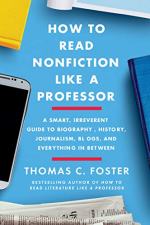
|
| Name: _________________________ | Period: ___________________ |
This quiz consists of 5 multiple choice and 5 short answer questions through Section 4: Chapter 13,"On the Stump" through Chapter 15, "Reading Internet Sources".
Multiple Choice Questions
1. In Chapter 12, "Life from the Inside," Foster discusses primary and secondary sources. Which of the following would be a secondary source about World War Two?
(a) A 1942 letter from an overseas American soldier to his parents.
(b) An editorial in the New York Times opposing American involvement in the war.
(c) A historical account in a 2020 textbook about the attack on Pearl Harbor.
(d) A collection of English WWII military maps and charts discovered many years after the war.
2. In Chapter 15, "Reading Internet Sources," what does Foster call the "fatal flaw" of the internet?
(a) The hierarchy of gatekeepers.
(b) The cost of connecting to it.
(c) A lack of quality control.
(d) Too many editors.
3. In Chapter 13, "On the Stump," Foster says that the outsider exposé has what advantage over the insider exposé?
(a) Objectivity.
(b) Perspective.
(c) Immediacy.
(d) Accuracy.
4. In Chapter 14, "The Universe of Ideas/Ideas of the Universe," why does Foster introduce the example of Malcolm Gladwell?
(a) To show how a clever writer can overcome public skepticism.
(b) To provide an example of amateur profiling.
(c) To contrast with the more rigorous writing of Neil deGrasse Tyson.
(d) To illustrate the idea of a science writer who has developed a "brand" for his writing.
5. In Chapter 14, "The Universe of Ideas/Ideas of the Universe," what does Foster say is true about contemporary America?
(a) There is not much great science writing going on in America today.
(b) America is the most scientifically advanced nation on earth.
(c) Many Americans are antiscientific.
(d) Americans are educated to read science critically.
Short Answer Questions
1. Chapter 15, "Reading Internet Sources," ends with the date of singer Roy Orbison's birthday. What is Foster's purpose in placing this piece of information here?
2. In Chapter 5, "It May Just Be Me, But..." what does Foster say about disclaimers like "I don't dislike soccer" (52)?
3. In "Interrogating the Text," Foster says that source material should be "apt." He means that source material should be what?
4. Whose Apologia Pro Vita Sua is discussed in Chapter 11, "Life from the Inside"?
5. In Chapter 12, "Life from the Inside," Foster says that an author of a history about long-ago events is not really so much a reporter as a what?
|
This section contains 442 words (approx. 2 pages at 300 words per page) |

|




